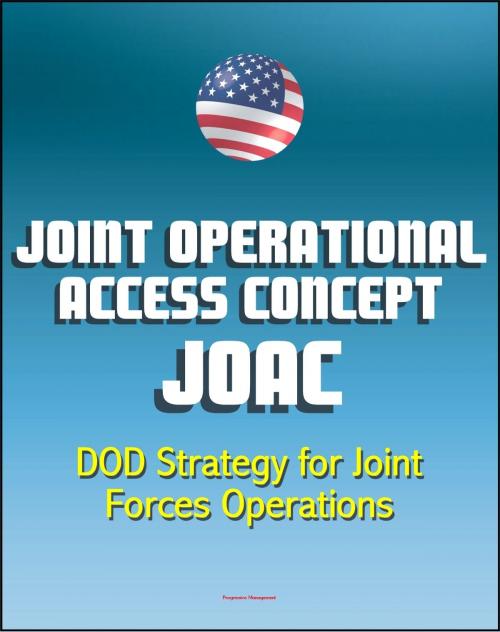Joint Operational Access Concept (JOAC): Department of Defense (DOD) Strategy for Joint Forces Operations in Response to Emerging Antiaccess and Area-Denial Security Challenges
Nonfiction, History, Military, Strategy, Social & Cultural Studies, Political Science, International| Author: | Progressive Management | ISBN: | 9781465738097 |
| Publisher: | Progressive Management | Publication: | March 8, 2012 |
| Imprint: | Smashwords Edition | Language: | English |
| Author: | Progressive Management |
| ISBN: | 9781465738097 |
| Publisher: | Progressive Management |
| Publication: | March 8, 2012 |
| Imprint: | Smashwords Edition |
| Language: | English |
This is a flowing-text ebook format reproduction of an important Department of Defense (DOD) strategy document describing in broad terms how joint forces will operate in response to emerging antiaccess and area-denial security challenges.
From the foreword by Martin Dempsey:
Due to three major trends - the growth of antiaccess and area-denial capabilities around the globe, the changing U.S. overseas defense posture, and the emergence of space and cyberspace as contested domains - future enemies, both states and nonstates, see the adoption of antiaccess/area-denial strategies against the United States as a favorable course of action for them. The JOAC describes how future joint forces will achieve operational access in the face of such strategies. Its central thesis is Cross-Domain Synergy—the complementary vice merely additive employment of capabilities in different domains such that each enhances the effectiveness and compensates for the vulnerabilities of the others—to establish superiority in some combination of domains that will provide the freedom of action required by the mission. The JOAC envisions a greater degree of integration across domains and at lower echelons than ever before. Embracing cross-domain synergy at increasingly lower levels will be essential to generating the tempo that is often critical to exploiting fleeting local opportunities for disrupting the enemy system. The JOAC also envisions a greater degree and more flexible integration of space and cyberspace operations into the traditional air-sea-land battlespace than ever before.
Each Service has an important role in ensuring Joint Operational Access. The JOAC was developed by representatives from each of the Services and the Joint Staff in coordination with the combatant commands, multinational partners, and other stakeholders. The JOAC development was supported by an experimentation campaign including a multi-scenario wargame, multiple Service-sponsored events, and other concept development venues.
The strategic challenge is clear: the Joint Force must maintain the freedom of action to accomplish any assigned mission. The Joint Operational Access Concept is a critical first step in ensuring the joint force has the requisite capabilities to do so.
This paper proposes a concept for how joint forces will achieve operational access in the face of armed opposition by a variety of potential enemies and under a variety of conditions, as part of a broader national approach. Operational access is the ability to project military force into an operational area with sufficient freedom of action to accomplish the mission. Operational access does not exist for its own sake, but rather serves our broader strategic goals, whether to ensure access to commerce, demonstrate U.S. resolve by positioning forces overseas to manage crisis and prevent war, or defeat an enemy in war. Operational access is the joint force contribution to assured access, the unhindered national use of the global commons and select sovereign territory, waters, airspace and cyberspace. Enduring requirement for force projection. Distinction between antiaccess and area-denial. Importance of preconditions.
This is a flowing-text ebook format reproduction of an important Department of Defense (DOD) strategy document describing in broad terms how joint forces will operate in response to emerging antiaccess and area-denial security challenges.
From the foreword by Martin Dempsey:
Due to three major trends - the growth of antiaccess and area-denial capabilities around the globe, the changing U.S. overseas defense posture, and the emergence of space and cyberspace as contested domains - future enemies, both states and nonstates, see the adoption of antiaccess/area-denial strategies against the United States as a favorable course of action for them. The JOAC describes how future joint forces will achieve operational access in the face of such strategies. Its central thesis is Cross-Domain Synergy—the complementary vice merely additive employment of capabilities in different domains such that each enhances the effectiveness and compensates for the vulnerabilities of the others—to establish superiority in some combination of domains that will provide the freedom of action required by the mission. The JOAC envisions a greater degree of integration across domains and at lower echelons than ever before. Embracing cross-domain synergy at increasingly lower levels will be essential to generating the tempo that is often critical to exploiting fleeting local opportunities for disrupting the enemy system. The JOAC also envisions a greater degree and more flexible integration of space and cyberspace operations into the traditional air-sea-land battlespace than ever before.
Each Service has an important role in ensuring Joint Operational Access. The JOAC was developed by representatives from each of the Services and the Joint Staff in coordination with the combatant commands, multinational partners, and other stakeholders. The JOAC development was supported by an experimentation campaign including a multi-scenario wargame, multiple Service-sponsored events, and other concept development venues.
The strategic challenge is clear: the Joint Force must maintain the freedom of action to accomplish any assigned mission. The Joint Operational Access Concept is a critical first step in ensuring the joint force has the requisite capabilities to do so.
This paper proposes a concept for how joint forces will achieve operational access in the face of armed opposition by a variety of potential enemies and under a variety of conditions, as part of a broader national approach. Operational access is the ability to project military force into an operational area with sufficient freedom of action to accomplish the mission. Operational access does not exist for its own sake, but rather serves our broader strategic goals, whether to ensure access to commerce, demonstrate U.S. resolve by positioning forces overseas to manage crisis and prevent war, or defeat an enemy in war. Operational access is the joint force contribution to assured access, the unhindered national use of the global commons and select sovereign territory, waters, airspace and cyberspace. Enduring requirement for force projection. Distinction between antiaccess and area-denial. Importance of preconditions.















